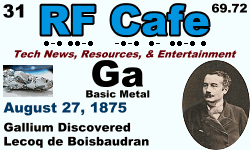|
  August 27 August 27
Today is
Tarzan's birthday (1912). 413 B.C.:
An eclipse of the moon caused panic on
Athens fleet. 1850:
Augusto Righi, who first showed that radio waves displayed characteristics
of light wave behavior in the manner of reflection, refraction, polarization and
interference, was born. 1858: The first cabled news dispatch was sent and was published
by "The New York Sun" newspaper.
1958:
Ernest Lawrence, inventor of the cyclotron, and after whom the
Lawrence Livermore National Laboratory
was named, died. 1859: The first oil well was successfully drilled in the U.S. by
Colonel Edwin
Drake near Titusville, PA. 1875: The element
gallium (Ga, 31)
was discovered by
P.E. Lecoq de Boisbaudran. 1877: Charles Rolls, half of
Rolls-Royce,
was born. 1898:
John Hopkinson, who developed Hopkinson's Law of magnetism and
invented the 3-phase AC generator, died. 1950: The
BBC transmitted the first ever live television pictures across
the Channel. 1962: The Mariner 2 space probe was launched to fly to Venus. 1989: The
first U.S. commercial satellite rocket was launched with a
British communications satellite was onboard. 2003: The world's
largest battery, made from
13,760 NiCad cells, was connected to provide emergency power to
Fairbanks, AK.
| Jan
| Feb | Mar |
Apr | May |
Jun | Jul |
Aug | Sep |
Oct | Nov |
Dec |
Note: These
historical tidbits have been collected from various sources, mostly on the Internet.
As detailed in
this article, there
is a lot of wrong information that is repeated hundreds of times because most websites
do not validate with authoritative sources. On RF Cafe, events with
hyperlinks have been verified. Many years ago,
I began commemorating the birthdays of notable people and events with
special RF Cafe logos.
Where available, I like to use images from postage stamps from the country where
the person or event occurred. Images used in the logos are often from open source
websites like Wikipedia, and are specifically credited with a hyperlink back to
the source where possible.
Fair Use laws permit
small samples of copyrighted content.
|










